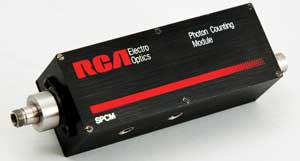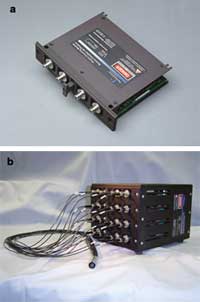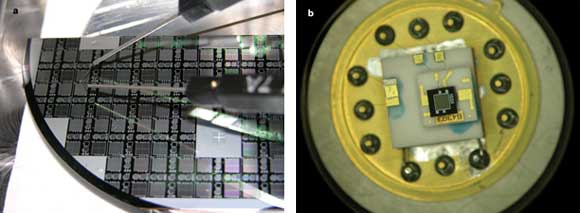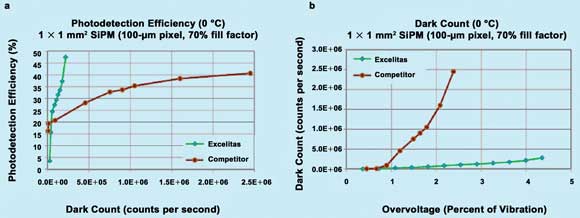The Evolution of the Geiger-Mode Silicon Avalanche Photodiode for Single-Photon Counting
Bernicy Fong, Excelitas Technologies Corp.
Since the photomultiplier tube (PMT) was
invented in the mid-1930s, it has remained the principal detector for experiments
involving a small number of photons. However, its low photon detection efficiency
and high sensitivity to magnetic fields forced researchers and systems designers
worldwide to find alternatives for single-photon detection.
The foundation for the development of the Geiger-mode silicon
avalanche photodiode (G-SAPD) was laid in 1961, when Dr. Robert J. McIntyre of RCA
Electro-Optics Canada presented his theory of microplasma instability in silicon.
McIntyre’s team then researched operating the avalanche photodiode (APD) above
the breakdown voltage – the so-called Geiger mode – and enabling single-photon
detection with silicon APDs.
The first G-SAPD single-photon-counting detector, generally referred
to as the single-photon avalanche diode, was developed in 1986 using the SLIK structure
(superlow K-factor, or superlow excess noise factor structure) by Excelitas Technologies
Canada, the former Electro-Optics division of RCA Canada. In the wake of innovations
by Rockwell International, G-SAPD photon-counting detector structures were introduced
by Radiation Monitoring Devices Inc. and Hamamatsu Photonics.
In the past 50 years, tremendous progress has been made in the
area of single-photon counting based on G-SAPD. Applications such as adaptive optics,
single-molecule analysis, positron emission tomography and time-domain fluorescence
spectroscopy, as well as market demand for cost-effectiveness, have been instrumental
in driving its development. These advances range from a single-active-area device
to multicell silicon photomultipliers (SiPMs); from the simple analog-mode avalanche
diode to a digital photon-counting module; and from multiphoton detection to the
analysis of their spatial resolution.
To facilitate the use of G-SAPDs, the first commercialized single-photon-counting
module was introduced in 1987 (Figure 1). It was a self-contained, user-friendly
device with built-in temperature control, a stabilized high-voltage supply and a
Geiger-mode avalanche photodiode passive quenching circuit. With its low dark count,
low timing jitter, low afterpulse and a photon detection efficiency (PDE) of more
than 50 percent, this first-generation module enabled single-photon studies to move
deeper into the red and near-infrared regions of the electromagnetic spectrum.

Figure 1. The first commercial Geiger-mode silicon avalanche photodiode single-photon-counting module by RCA, the SPCM-100, was introduced in 1987. Courtesy of Excelitas Technologies Corp.
In the 1990s, this single-photon-counting module enabled the start
and development of fields such as single-molecule detection, fluorescence sensing
and quantum cryptography, which by now are critical in research and commercial fields
such as biology and astronomy. The ability to detect single photons made it possible
to work with nanoliter or picoliter samples without amplification. Biomedical studies
of vaccines, bioreagents and pharmaceuticals were some of the first beneficiaries
of this compact solid-state photon-counting module. Applications such as near-field
scanning microscopy and laser-induced fluorescence in single-molecule detection
became easier and more effective with the high PDE. More choices opened up as well
within the laser-induced fluorescence sector because it was now possible to see
and analyze weak fluorescence in the green and red.
But a passive quenched solid-state photon-counting module is quite
slow; the device is inadequate for time-correlated fluorescence spectroscopy and
Förster resonance energy transfer, which need faster rise times and higher
count rates. The next-generation module evolved to integrate active quenching circuitry,
which today is the norm for all such devices.
Photon-counting detectors with good timing resolution or time
jitter can measure the molecular dynamics of nanometer-scale structures at picosecond-long
fluorescence lifetime changes. New applications in time-resolved fluorescence
studies have led to the development of low-timing-resolution G-SAPD single-photon-counting
modules by various companies within the past decade. These optimized modules have
superior low timing jitter performance of less than 100 ps, although most have active
detection areas of 50 μm or smaller and lower PDE in the green and red regions.
In the early to mid-1990s, high-throughput fluorescence detection
for drug discovery and genome DNA-sequencing projects led the trend toward larger-number
screening applications in biotechnology using small amounts of reagents and samples.
At the same time, single-photon counting in high-resolution imaging was being explored
for time-resolved fluorescence microscopy, x-ray imaging and PET with CT imaging.
These movements fueled an increase in demand for multichannel G-SAPD photon-counting
arrays for increasing throughput in screening experiments and various types of ultrahigh-resolution
imaging.

Figure 2. (a) Four- and (b) 16-channel single-photon-counting modules.
Courtesy of Excelitas Technologies Corp.
Such an array would provide researchers the means to study several
aspects of photons simultaneously over many channels. It would mean that original
equipment manufacturers such as pharmaceutical companies could increase the speed
of multiple drug analysis. Time-resolved acquisition of fluorescence lifetimes in
DNA microarray imaging could be achieved with high resolution in the red. A PET/CT
combination to provide whole-body anatomical (CT) and functional (PET) diagnostics,
including localization of cancer, could significantly reduce the time and cost associated
with disease investigation and treatment.
Various advances were made in building multichannel G-SAPD single-photon-counting
arrays in the 1990s through early 2000s. Formats included monolithic G-SAPD chip
arrays and individual single-photon-counting modules with output signals from each
detector while sharing the high-voltage power supply and quenching electronics (Figure
2).
In the late 1990s came one of the most promising single-photon-counting
arrays to evolve. It was the complementary metal oxide semiconductor (CMOS) process-based
multipixel Geiger-mode avalanche photodiode, often referred to as the SiPM, the
solid-state photomultiplier or the multipixel photon counter. This silicon device
is a matrix of small Geiger-mode-operated APD cells connected in parallel to a quenching
resistor in series. The basis for this design originated in Russia, and by and large
it owes its existence to the metal resistor semiconductor APD, a p-n structured
silicon APD with a thin layer of titanium and a layer of high-resistivity SiC or
SixOy to limit its Geiger-mode breakdown (Figure 3).

Figure 3. (a, b) A silicon photomultiplier by Moscow State Engineering Physics Institute.
The SiPM has some of the most desirable attributes of a solid-state
single-photon-counting device: high gain (105 to 107), high PDE in the blue, low
operating voltage (40 to 100 V), low single-photon timing resolution (average 100
ps), magnetic field insensitivity, compact size but larger active areas (1 to 10
mm2), and the ability to differentiate between single and multiple photons. The
most attractive feature of these microcell G-SAPDs is that they can be manufactured
using the conventional CMOS process. They could be easily producible in high volume
and at fairly low cost; at the wafer level, low-power CMOS electronics, such as
analog-to-digital conversion circuitry, could be integrated into the SiPM.
For applications such as x-ray and medical imaging where many
detectors are needed, the SiPM could significantly reduce the overall system cost
and footprint. For point-of-care diagnostics, where small, rugged, portable and
inexpensive instruments are sought after, the SiPM would make that possible. Currently,
single SiPMs and SiPM arrays in either diode or module form are available commercially
from several companies. However, the weaknesses of the SiPM – such as high
dark count, high optical crosstalk, high afterpulse and low PDE in the green through
red – have hindered its adaptation in many popular biomedical single-photon-counting
domains.
Through ongoing research, many investigators have already found
promising ways to improve the design and performance of the SiPM. Recently announced
results from Excelitas Technologies show dark counts of their 1-mm2 SiPM to be orders
of magnitude lower than those of previous models, while the PDE is higher than that
of currently available commercial devices (Figure 4). Nevertheless, more work is
needed on the overall performance of this product for it to be widely established
commercially in applications such as cell sorting and sizing, protein analysis and
biomolecular diagnostics.

Figure 4. (a, b) These graphs demonstrate recently published results
from Excelitas Technologies on its 1-mm2 silicon photomultipliers. Presented in July 2011 in Lyon, France, at the International Conference on New Developments in Photodetection.
Other frontiers of the G-SAPD single-photon detector are being
explored. Among these are pushes for a fully integrated digital SiPM variant that
can detect single and multiple photon hits as well as their timing and intensity,
and single and compact monolithic G-SAPD arrays with much higher PDE for photon
counting in the red and some even in the near-infrared. Ultimately, the G-SAPD single-photon-counting
detector of the future must be a combination of all the sought-after features of
the PMT and solid-state single-photon-counting technologies and must meet the growing
needs of biomedical and life sciences applications.
Meet the author
Bernicy Fong is an applications specialist at Excelitas Technologies
Corp. in Vaudreuil, Québec; e-mail: [email protected].